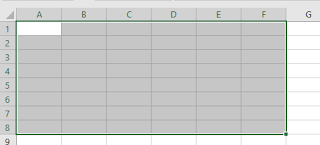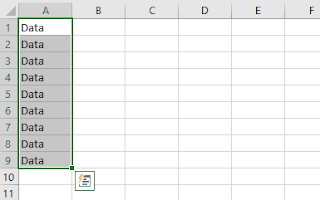
- Managing the databases
- For processing electronic worksheet
- Manipulation of string data
- For calculation and manipulation of numbers
- To prepare budgets
- Graphical representation of data
- Prepare time table and chart
- Prepare various reports.
When we start MS-Excel then we can see it's window on the screen and this window includes various parts such as:

- Quick access toolbar- we can see Quick access toolbar above the ribbon. It gives access to commands frequently used. It has three buttons Save as, Undo, Redo by default but we can customise or add any button to it that we require frequently.
- Title bar- Excel displays the name of the workbook using title bar and it is located at the top of the Excel window. It also includes Minimise, Maximize and Close buttons.
- Ribbon- It is located below the Quick access toolbar and there are many tabs, each tab displays several relative command groups.
- Formula bar- In this bar, the cell address of the active cell is displayed in the Name box which is located on the left side of the formula bar. Also we can edit content of a cell using formula bar.
- Status bar- This bar is located at the bottom of the Excel window and provides information such as the sum, average, minimum and maximum value of selected numbers. By right clicking on the status bar we can change what displays on the status bar.
Workbook- A workbook or book is a single file created with an electronic spreadsheet program such as Microsoft Excel or Google Sheets.
Spreadsheet- A spreadsheet is a computer application program that simulates a physical spreadsheet by capturing, displaying and manipulating data arranged in rows and columns.
Worksheet- Worksheet is a sheet that is a collection of cells organized in rows and columns. Each Worksheet contains 1048576 rows and 16384 columns to organize information.
Working in worksheet of MS-Excel
Using the arrow keys- We can use Arrow keys to move around worksheet. We can use Down arrow key to move downward one cell at a time and Up arrow key to move upward one cell at a time. Also we can use Left and Right Arrow keys to move left and right one cell at a time.
Using navigation keys- We can use Page Up and Page Down keys to move up and down respectively one page at a time and also we can use Ctrl + Home keys together to move to the beginning of the worksheet e.g. cell A1
| Sr. No. | Keys | Function |
|---|---|---|
| 1 | Up arrow key | To shift one cell up |
| 2 | Down arrow key | To shift one cell down |
| 3 | Left arrow key | To shift one cell left |
| 4 | Right arrow key | To shift one cell right |
| 5 | Home | To go to the first column of the selected row |
| 6 | Ctrl + Home | To go to the beginning of the worksheet or cell A1 |
| 7 | Ctrl + End | To go to the bottom of the worksheet |
| 8 | Ctrl + Right arrow key | To go to the end of row |
| 9 | Ctrl + Left arrow key | To go to the end of column |
| 10 | Page Up | To move up one page at a time |
| 11 | Page Down | To move down one page at a time |
| 12 | Ctrl + G | To go to a particular cell in the worksheet |
Selecting cells
To perform a function on a group of cells, we must first select those cells by highlighting them.
To select an area, we need to hold down the left mouse button and drag the mouse over that area.

Entering data
We can enter data in a cell by using following steps:

- First we need to click on the cell where we want to enter the data
- Now we can type the data then and insertion point appears in the cell.
- After typing data we can press tab key to go to next cell.
Deleting data
We can use Backspace key to erase one character at a time in a active cell.
Editing a cell data
To edit the entered data, first we need to click on the cell whose data we want to edit and then we can press F2 function key.
Also we can edit cell data by using formula bar or we can double click on the cell that we want to edit
Wrap text
When the typed text is too long to fit in the cell, then the text overlaps the next cell.
To avoid this, we can wrap the text by using following steps:
- First we need to select the cell where text overlaps the next sell
- Now we can select the Home tab
- Now we can click Wrap text button located in the Alignment group and then our text will be wrapped
Delete a cell entry
To delete an entry in a cell or group of cells, place the cursor in the cell or select the group of cells and then by pressing Delete key we can delete an entry in a cell or a group of cells.
Filling a range of cells
To fill the range of cells we can use following steps:
- Select the cell
- Type the data in the cell
- Position the mouse pointer over fill handle (+)
- Press fill handle with left mouse button and drag the mouse to select the range of of cells and then we can release the mouse button.
Or
We can also perform the above task using second method. Press Shift key and Down arrow key to select the range of cells. Now we can press Ctrl + d shortcut key to fill the data.

Now the content of the first cell will be copied to all the cells of selected range.
Creating a data series
Data series is a series of numbers. Excel can enter numbers automatically in form of series.

Using following steps we can generate data series
- Type 10 in cell A1
- Now type 11 in cell A2
- Now we need to select both the cells
- Now position the mouse pointer over the fill handle
- Now we can click and hold left mouse button and drag it down
Creating a series of month of year
- Type January in cell A1
- Now type February in cell A2
- Now we need to select both the cells
- Now position the mouse pointer over the fill handle
- Now we can click and hold left mouse button and drag it down

UNIT-104
Digital Data Tabulation-Spreadsheet
- Introduction and Concepts of Spreadsheet and Workbook
- How to Create, Save, Open, Preview, Print and Close Worksheet
- How to Enter Numbers, Text, Date and Time, Series using Auto Fill
- Editing and Formatting of Worksheet
- Changing Color, Size, Font, Alignment of Text
- Inserting/Deleting cells, Rows and Columns
- Entering Formula in cell using operator (+, -, x, /) etc
- Cell Referencing(Relative, Absolute and Mixed)
- Functions(SUM, AVERAGE, MAX, MIN, IF)
- Inserting tables in Worksheet
- Charts(Lines, Pie, Bar, Column, Area)
- Macros in Worksheet

